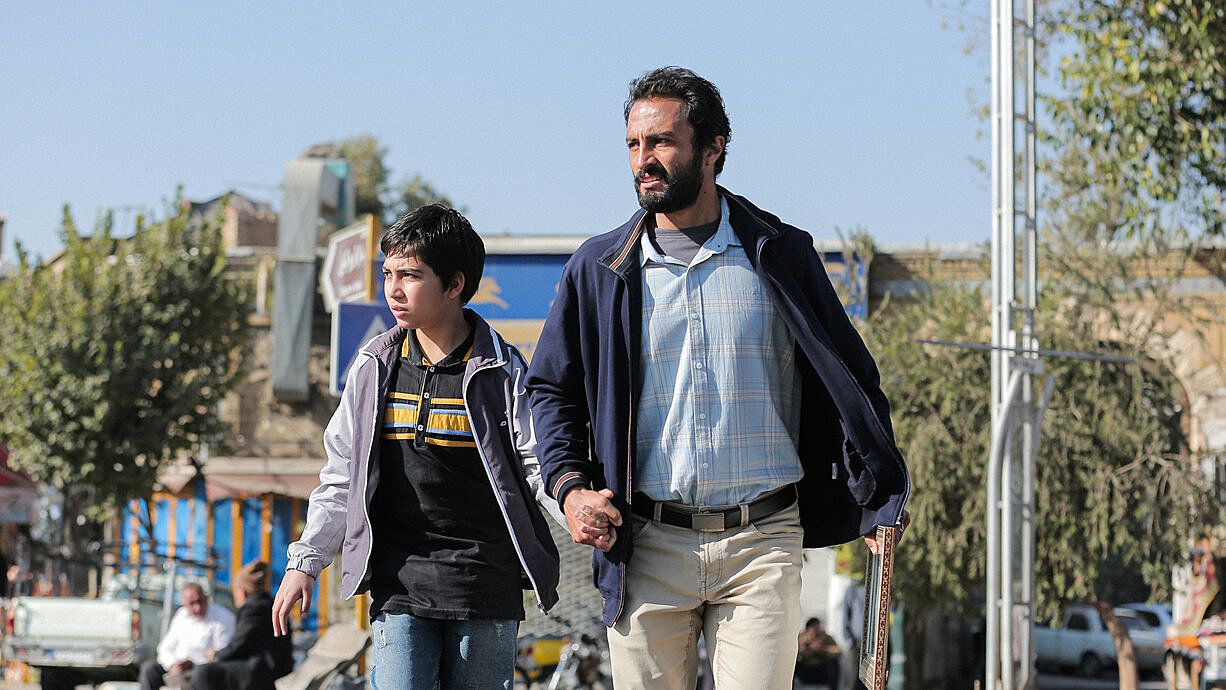A Morality Tale for the 21st Century
In reviewing Asghar Farhadi’s A Hero, filmmaker Ghazaleh Golbakhsh contextualises Iran–US relations, censorship and the popularity of Iranian films.
In 2012, for the first time in the Oscars’ 84-year history, the Best Foreign Language Film (now known as Best International Feature Film) went to Iran’s A Separation (2011) by Asghar Farhadi. A year later, the Hollywood studio film Argo (2012), a film in which Hollywood and the CIA are heralded while Iran and Iranians are vilified, won Best Picture. The hypocrisy and irony here are not unprecedented when you look at the two countries’ turbulent historical relationship. Just as these two wins prove the world is never simple or black and white, so does Asghar Farhadi’s new offering, A Hero (2021), playing now at the NZIFF.
Our story follows Rahim (played by the charmingly empathetic Amir Jadidi), a young working-class man in Iran’s culturally rich southern city of Shiraz who is on parole from debtor’s prison for two days. He meets his girlfriend Farkhandeh (Sahar Goldust), who hands him a woman’s purse full of gold coins that she found at a bus stop. This could help him pay off his creditor, leave prison and finally allow them to get married. But when the coins turn out to be less valuable than they thought, Rahim rethinks his actions and instead decides to return them to their owner. On one hand, he feels morally this is the ‘right’ thing to do, and on the other, he knows this will also help his case.
The film has been touted as Farhadi’s most universal, with its traditions of honour and truth, and a social media focus helping to modernise it. Still, it is a very Iranian film
When the prison authorities hear of such honesty, particularly from a convict, they jump for the chance to celebrate and exploit Rahim’s goodness. News cameras, social media fame and an award ceremony heap praise on Rahim, who cannot help but enjoy the adulation, particularly as donations towards his debt begin to flow in. Rahim becomes a modern-day working-class hero, damning his wrongs and finding a new righteous path through honesty and honour.
However, as is Farhadi’s brilliance, Rahim’s newfound fame begins to twist into darker knots, and the heroism of Rahim is suddenly questioned on social media. The public no longer believes in Rahim’s story and numerous plot points and missteps allow the film to rise to a desperate climax. Rahim, Farkhandeh and Rahim’s family then attempt to prove that Rahim is indeed telling the truth.
The film has been touted as Farhadi’s most universal, with its traditions of honour and truth, and a social media focus helping to modernise it. Still, it is a very Iranian film.
Iranian film history is as old as cinema, beginning with the Lumière brothers first screening their works in 1895
Much of the film explores societal ideologies around morality. What is wrong and right? What makes a decent person? The nod to religion here is obvious as all Iranian cinema is strictly regulated and censored by the Ministry for Culture and Islamic Guidance. Because of this, sometimes some of the nuances within the film get lost in translation. One critic asked why Rahim did not just hand in the bag to the police, but the distrust in authority and government is so deeply entrenched in Iranian society that it makes perfect sense to an Iranian audience.
Further examples of the unmistakable hand of the censor include the way Farkhandeh cannot even hug, let alone kiss, her beloved when she finally sees him out of prison. Even within the privacy of their own homes, we see women continue to wear a hijab due to the presence of the film camera. Farhadi himself notes how his films would likely be different if he could produce them outside of Iran.
Despite these restrictions, or even as a result, Iranian cinema has become renowned, with much of its global reach owing to the (new) New Wave of the 1980s and 1990s where ‘new’ filmmakers such as the late Abbas Kiarostami were ‘discovered’ in the West. The quotation marks are valid as Kiarostami, like the Iranian film industry itself, had been creating works for decades. In fact, Iranian film history is as old as cinema history, beginning with the Lumière brothers first screening their works there publicly in 1895.
Iranian New Wave consists of social realist films that mix fiction and documentary modes of filmmaking
Iranian New Wave consists of social realist films that mix fiction and documentary modes of filmmaking, and is similar in many ways to other arthouse and European cinemas, such as Italian neorealism, which also emerged after a catastrophic war (Iranian New Wave came about after the disastrous Iran–Iraq war of the 1980s). Social realist films are low budget, character focused and often show ‘everyday’ people.
A Hero, much like A Separation, is also about the class system and the disenfranchised, in this case a working-class character like Rahim, who tries to do good but is still ultimately chastised by society, due to his background. If he was a man of great wealth or prestige, would the same have happened? This is perfectly encapsulated in the taxi driver who admits his own past in prison and aims to help Rahim out, despite barely knowing him.
However, unlike many other New Wave filmmakers, Farhadi also opts to follow other groups of people instead of consistently exoticising the poor. A Separation looks at the clash between a middle-class family and their servant, while About Elly (2009) explores the relationships between a group of young, middle-class Tehranis on vacation near the Caspian Sea.
In this film we are rooting for everyone, an impossible feat in a world where everyone is pitted against one another
The popularity of the Iranian New Wave in the West was an antithesis to dominant Hollywood cinema. Iran and Iranians were often vilified in Western media, particularly in Hollywood films, to the extent that audiences yearned to know more about the ‘real’ Iran, particularly those who attended film festivals. The global media focus on Iran, from the hostage crisis that followed Iran’s 1979 revolution to the state’s constant opposition to the West, also paved the way for the success of independent Iranian cinema.
The Iranian New Wave was a term created in the West, after the initial success of films like Kiarostami’s A Taste of Cherry (1997), which won the Palme d’Or at the Cannes Film Festival, as did Majid Majidi with Baduk (1992) and Jafar Panahi with The White Balloon (1995). Even today, Iranian cinema’s popularity in film festivals is still apparent, as shown by the whopping four films from the country in this year’s NZIFF – including the successful debut film, Hit the Road (2021), by Jafar Panahi’s son, Panah Panahi.
In some ways, I feel that Farhadi’s films offer a new, fresh take on traditional stories, and despite the subtleties, garner all sorts of emotions from the viewer – whether they want to feel them or not. That is the real beauty and tragedy in A Hero. We are rooting for everyone, and this becomes an impossible feat in a world where everyone is pitted against one another. [Spoiler alert] In the end, Rahim sticks to his convictions and once again does the ‘right’ thing. For an audience who has been with him from the start, this is bittersweet and, filmwise, unsatisfying. Some critics have noted this, but in a grey world where good and bad are muddied and truth and opinion are weighed the same, what possible ending could be satisfying? As in life, there is no perfect resolution.

